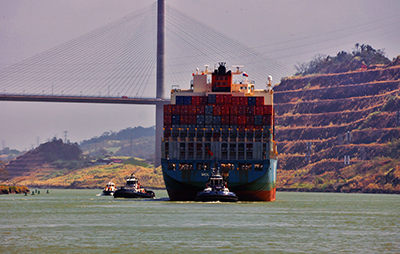Following the close of its 2017 fiscal year, Panama Canal authorities announced that the entrepot welcomed a record 403.8 tons – the largest amount of annual volume ever transited in its 103-year history. Industry analysts say the impact on U.S. ocean cargo gateways will soon become evident.
According to its latest throughput figures, the Panama Canal transited a total of 13,548 vessels during its fiscal year (FY17), representing a 3.3 percent increase compared to totals the year before. Thanks to the larger Neopanamax vessels now able to transit the expanded Canal, the growth in traffic translated into a 22.2 percent increase in total annual tonnage from FY16, and helped the Panama Canal surpass the already ambitious cargo projection of reaching 399 million tons.
“These record figures reflect not only the industry’s confidence in the Expanded Canal, but also illustrate our continued ability to transform the global economy and revitalize the maritime industry,” says Panama Canal Administrator Jorge L. Quijano.
The past year's results also include many significant milestones. Less than eight months after inauguration of the Expanded Canal, it welcomed the YM Unity containership, its 500th Neopanamax vessel transit. In March 2017, Mediterranean Shipping Company’s MSC Anzu became the 1000th Neopanamax vessel to transit the Canal. The September 2017 transit of the COSCO Yantian containership marked 2,000 Neopanamax transits.
After setting similar records in December 2016 and May 2017, the Neopanamax containership CMA CGM Theodore Roosevelt became the largest ship to transit the Canal to date in August 2017, carrying nearly 15,000 twenty-foot equivalent units (TEUs).
From here, the vessel called the Port of New York and New Jersey for the inauguration of the raised Bayonne Bridge.
The impact of the expanded Panama Canal was also apparent in many other ports along the U.S. East Coast, which were able to welcome the larger Neopanamax ships from the Canal and saw increased growth. Some even set records in terms of their year-on-year growth and the total amount of tonnage received - all of which can be directly attributed to the widening of the Panama Canal.
“Other ports recently completed, or are continuing to advance, a number of infrastructure projects that allow them to receive Neopanamax ships, as well,” observes Quijano.
The Panama Canal currently serves 29 major liner services, including 15 Neopanamax liner services, primarily on the U.S. East Coast to Asia trade route.
Chris Rogers, an analyst with the global trade consultancy, Panjiva, notes that the diversion of Asian-inbound traffic from U.S. West Coast ports to those on the East Coast “took a step forward” in September.
“Our data shows shipments to southeast ports increased by 26.9 % on a year earlier, while those to California increased by a more modest 7.7 %.”
As a consequence, in the third quarter, southeast ports handled 15.8 % of incoming traffic – the highest since February – while California's handled 54.6%, down from a peak of 55.5% in May.
SC
MR


Latest Supply Chain News
- How CPG brands can deliver on supplier diversity promises
- How S&OP provides the answer to in-demand products
- AI, virtual reality is bringing experiential learning into the modern age
- Humanoid robots’ place in an intralogistics smart robot strategy
- Tips for CIOs to overcome technology talent acquisition troubles
- More News
Latest Podcast

 Explore
Explore
Procurement & Sourcing News
- How CPG brands can deliver on supplier diversity promises
- How S&OP provides the answer to in-demand products
- There is still work to do to achieve supply chain stability
- Blooming success: The vital role of S&OE in nurturing global supply chains
- How one small part held up shipments of thousands of autos
- Shining light on procurement’s dark purchases problem
- More Procurement & Sourcing
Latest Procurement & Sourcing Resources

Subscribe

Supply Chain Management Review delivers the best industry content.

Editors’ Picks





